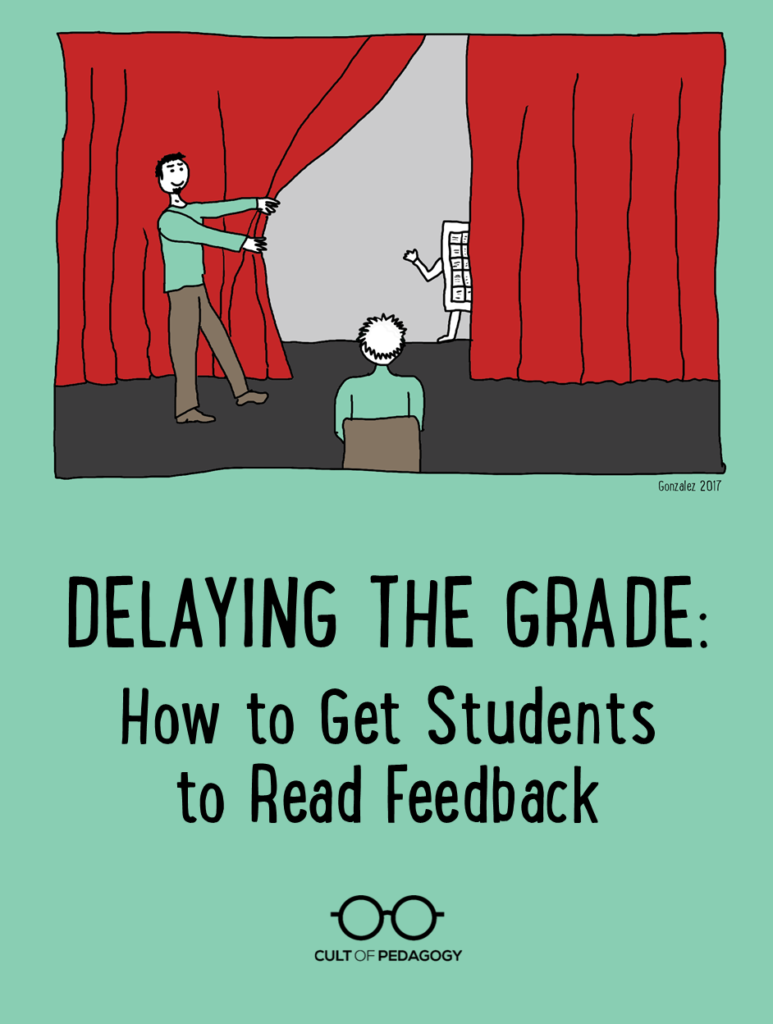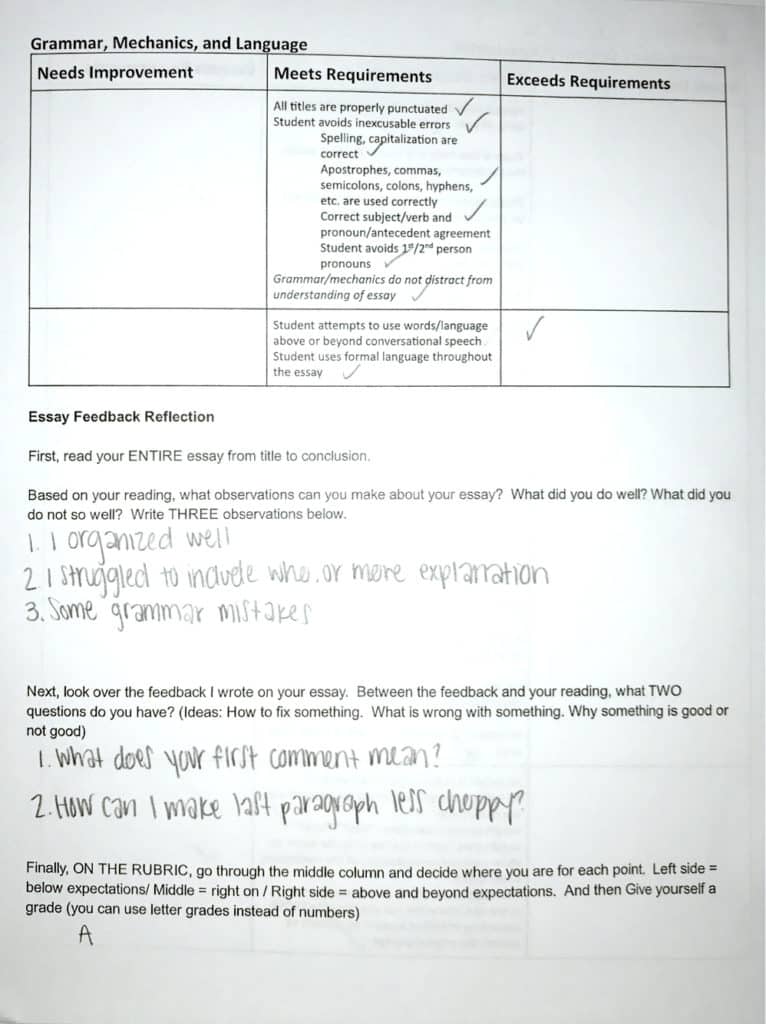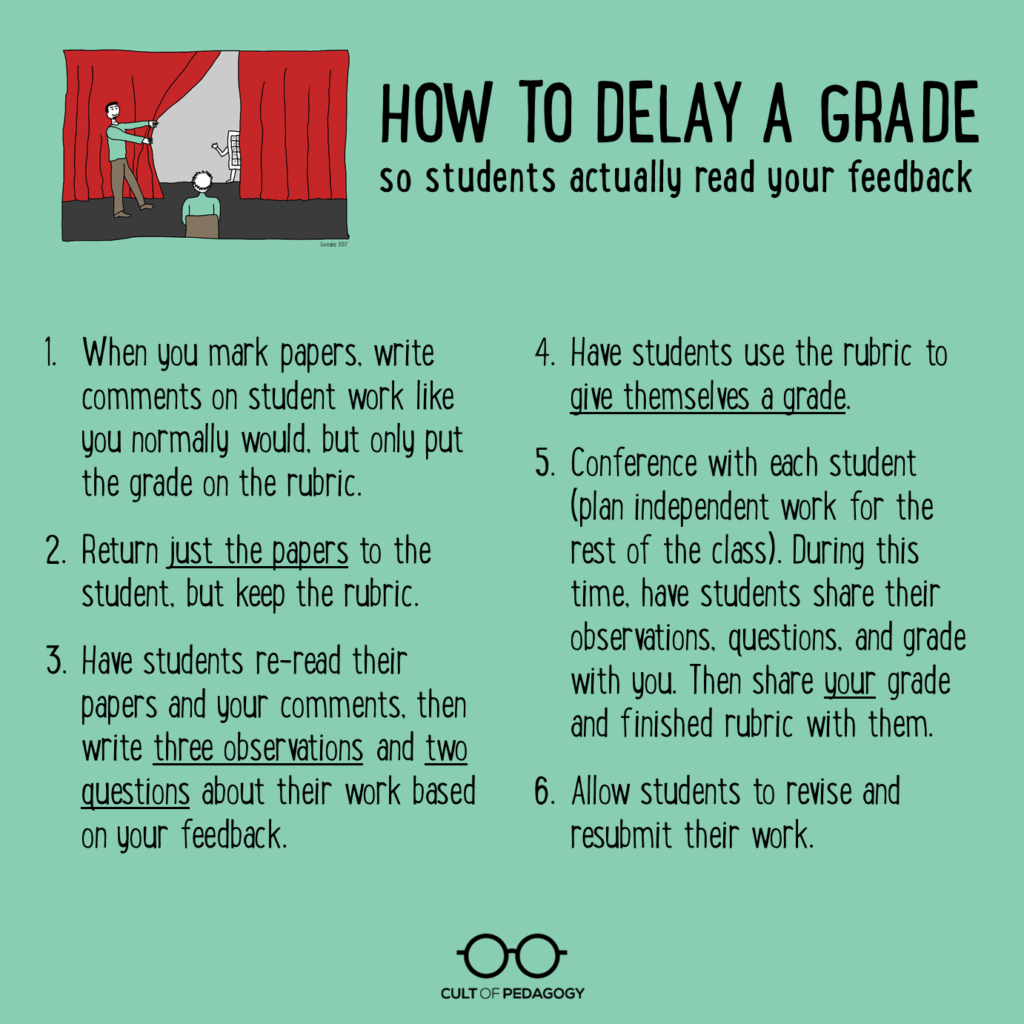Delaying the Grade: How to Get Students to Read Feedback

I have a confession to make: I am terrible at handing back papers. That sounds silly, right? I mean, you literally just hand the paper to the kid whose name is at the top.
But teachers everywhere know how disheartening that small act can be. (It can’t be just me, right?)
There are the eye rolls and the whispering to each other of “What did you get?” and “She gave me a ___.” Next thing you know, the paper you spent so long reading and marking has been shoved into the abyss of the backpack or tossed carelessly in the recycle bin.
Wow, glad I put so much time into that assignment, said no teacher ever.
I honestly got to a point where I would just wait so long to give things back, the kids would kind of forget, and then so would I. Oops.
In English I ask my students to write a lot. I don’t grade everything they write, but when it comes to the “big essays”—the graded, polished drafts—what grade they will receive becomes the sole motivator for their writing. This frustrates me, and, in my opinion, distracts them from what they should actually care about: writing.
This intense focus on the all-important grade was my least favorite part, and it was definitely what kept the stack sitting on the counter behind my desk…for an embarrassing amount of time. It really bothered me that kids didn’t care about the feedback I put on their essays, not just because I took the time to do it, but because I did it to help them. I want them to grow as writers, and most of them do throughout the year, but so many only seem to care about that number.
I won’t lie: It made me angry. Not only did I feel like I had wasted my time, I felt like they just didn’t care. And then the snowball of thoughts would start: How will they survive if they don’t care about feedback? What’s going to happen in college? Or when they get jobs? Ugh! I’m done!
After dealing with this for about nine years, I couldn’t take it anymore. I either had to get over it or fix it. Since I’m not usually one to give up, I set out to find a way to get my students to actually read their feedback and care less about the grade.
The Fix for Ignored Feedback
The solution was remarkably easy and accidentally originated out of my laziness (score one for being a little lazy!). Last year, kids had turned in essays on Google Classroom, but rather than pasting a completed rubric into their essay as I usually did, I made hard copies of the rubric and wrote on them. This meant that I could return papers with comments but without grades.
And from this a whole new system was born: Return papers to students with only feedback. Delay the delivery of the actual grade so student focus moves from the grade to the feedback.
The simple act of delaying the grade meant that students had to think about their writing. They had to read their own writing—after a few weeks away from it—and digest my comments, which allowed them to better recognize what they did well or not so well. The response from students was extremely positive; they understood the benefit of rereading their essays and paying attention to feedback. One boy said, “Mrs. Louden, you’re a genius. I’ve never read what a teacher writes on my essay before, and now I have to.”
The Plan
1. Grade the Papers
After collecting student papers, grade them (hard copy or electronic) as you usually would with comments on the written piece, but keep the rubric separate.
2. Plan Independent Work
Plan accordingly by creating opportunities for students to do independent or group work for a few days when it’s time to return papers to students. This is probably the most vital part of the process, because it will give you time to conference with individual students.
3. Return Papers
When you finish grading the papers, return just the written work to students, not the completed rubric. When I first tried this with students, I put the following directions up on the board when I returned the essays:
- Read over your whole essay, including what you wrote and my comments.
- Write THREE observations based on your reading and TWO follow-up questions to discuss with me at our conference. Ask about comments, how to improve things, how to do things differently, etc.
- Use the rubric (posted online) to grade yourself.
- Be ready to discuss all of this.
I now incorporate these instructions into the student copy of the rubric. Below is one page of that rubric, which includes the reflection section.

Student Reflection Form (get a blank copy here)
4. Time to Reflect
Return the essays during class, allowing time to explain, time for kids to read their essays, and time for them to clarify if needed. Encourage them to go slowly. (Bonus step: Walk around and listen. Hear the difference. Honestly, you probably won’t hear a lot of talking or comparing. If they are talking, it will be to themselves about what they are noticing.)
5. Conference with Each Student
This step is where the magic happens.
Since you’ve planned for independent work, you will have time to meet with each student individually. I do my conferences on a large whiteboard-painted table; I have found that since moving these from my desk to this table, our conferences are more productive. I’m not distracted by the stuff on my desk, kids are able to spread out (Chromebook, reflection, essay, etc.), and as a bonus, we can use the surface of the table when we need to do some planning. These meetings don’t have to be more than a couple of minutes per student.
- When kids get to my table, I start with “What do you want to talk about?” and let them guide the conference. It is so cool to hear what they have to say. So many of them make comments like “I can’t believe I did <insert careless mistake>” or “I’m sorry I turned it in like this” or “I’m embarrassed; I see so many mistakes!” Or my favorite: “You specifically told us not to do this.” The level of reflection is deeper than any I’ve ever encountered. I assure them that it is fine and I don’t expect perfection, but on the inside I’m so excited that they’re seeing the things I see.
- Next they usually ask questions. This is exciting because some of their questions make perfect teachable moments! I have watched many students grow this year from these conversations. Take Alex, for example. He writes the wordiest sentences I’ve ever read, but he’s gotten to the point where he puts his own comments on his essay as he writes so we can discuss while he’s still in the writing stage. At least half of these are related to wordiness. I’m excited that he’s learned to identify it, if not quite how to fix it yet.
- Finally, I end by asking students how they graded themselves according to the rubric. I enjoy this part because more often than not, they were much harsher on themselves than I was. I then share the rubric with the grade and the rest of my general comments. For once, kids are usually happy about their grade because it was higher than they expected, contrary to the old days when they’d say “she gave me C” but they thought they deserved an A.

6. Revision
I always offer students the opportunity to rewrite their essay. Above all else, my goal is to help students become better writers. If this means they have to do it a couple of times, then so be it. Depending on the assignment, these are the usual requirements:
- The student must meet with me 1 to 3 times (depends on the student and the essay) before it is due. These meetings are quick “check-in” style meetings: What are you planning to do? What have you done? What questions do you have?
- The student must make substantial revisions, not just grammatical edits.
- The student must turn in the original and the updated draft on time.
And that’s it! Okay, looking back over what I said, it sounds like a lot, but really it’s very easy for you. I think this is the best change I have made to the writing process in the last few years. Students have become more reflective (and sympathetic of how long it takes me to grade—haha!), their writing has improved, and I return papers much more quickly—and happily—than ever before. ♦
Join our mailing list and get weekly tips, tools, and inspiration—in quick, bite-sized packages—all geared toward making your teaching more effective and fun. You’ll get access to our members-only library of free downloads, including 20 Ways to Cut Your Grading Time in Half the e-booklet that has helped thousands of teachers save time on grading. Come on in!!